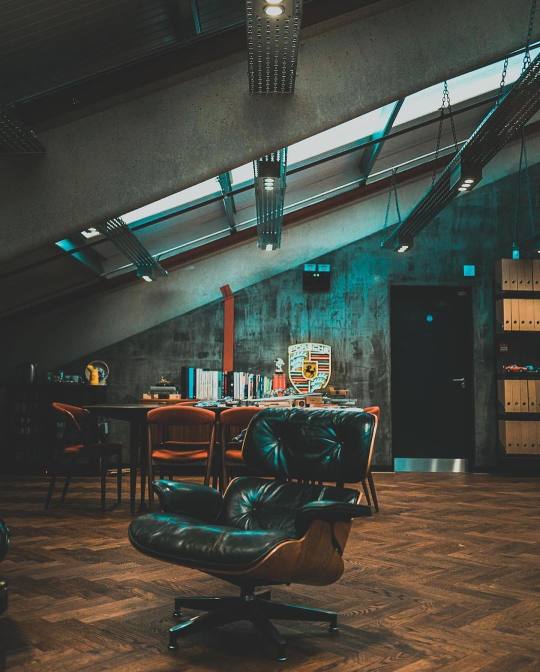#chapel annex
Text

Annex Bunk Room
164 notes
·
View notes
Text

Did You Know: There is archeological evidence that the Great Chapel of Zenithar may have been or was in the process of being converted to a Khajiiti temple following their annexation of the city in the First Era?
135 notes
·
View notes
Text
GILBERT VON OBSIDIAN EVENT STORY....

CHAPTER ONE.
Rhodolite’s horror night.
translations are not 100% accurate. expect mistakes.
minors and ageless blogs dni.
Gilbert: Hehe, I'm so happy. I never thought that the little rabbit would take my hand.
Emma:…..
Now there is only me and Prince Gilbert in the chapel.

Luke and Clavis immediately went to solve the mystery of a strange phenomenon different from us,
The situation was not so good, being alone with the prince of the enemy country.
(…Both of them told me to reconsider many times.)
(I wanted to reconsider, too. All I know is that I shouldn't have taken Prince Gilbert's hand.)
(It’s just——……)
━━FLASHBACK━━
Gilbert: Hey, little rabbit. I think the day will soon come when you will be forced to make a choice.
A few days ago, Prince Gilbert visited my room and scooped up my chin with his cane.
Gilbert: You'll definitely have to choose me then.
Emma: Why?
Gilbert: You won’t understand unless I tell you, right…?
━━FLASHBACK ENDS━━
(He’s threatening me.)
I can't make any bad resistance against Prince Gilbert, who has the title of the worldwide disaster and the trampling beast.
He’s the kind of person who doesn't make a joke about destroying a country if he gets into a bad mood.
Gilbert: What, you've got a look in your eyes like you want to say something.
Emma: No...it's nothing.
Gilbert: Hehe, that's good to know.
Gilbert: I was so nervous about what would happen if you didn't pick me.
(…The current situation is a lot scarier than the test of courage.)
(You’re definitely up to something. …Some kind of evil.)
That said, I have already had a fair amount of interaction with Prince Gilbert.
Unlike when I first met him, my body was unconditionally tense, now I’m becoming accustomed to him.
(It's true that he's a villain, but he's not the one who hurts me for no reason.)
Now that the situation had come to this, there was no turning back, so I decided to look forward.
Emma: Prince Gilbert...we are supposed to check the "Ghost Tower," which opens only at midnight, correct?
Gilbert: Yeah. That's what Clavis was talking about earlier.
━━FLASHBACK━━
Clavis: There is the so-called "unopened tower" in the annex of the Rhodolite Castle.
Clavis: The lock is broken and you can't normally get inside.
Clavis: Strangely enough, however, only in the middle of the night does the tower's door open and one can enter.
Clavis: Moreover, the tower should have already been reduced to ruins, but anyone says they saw the light, strange isn’t it?
Clavis: The servants are making a fuss about ghosts kept appearing and disappearing, and are reluctant to approach the tower.
Clavis: Well, it's not unreasonable. The tower was originally——
━━FLASHBACK ENDS━━
Gilbert: A tower for confining criminals before execution, wasn’t it?
Emma: Just like you said, Rhodolite used to have a system of public executions….
(There is no such system nowadays, but a tower where people who are about to die are locked….up.)
I don't believe in ghosts, but the tower has enough scenery to give me a premonition of what to expect.
(….I'm curious and interested, not to mention, there's a lot of fuss about it.)

Gilbert: Are you afraid?
Prince Gilbert closes the distance with me and looks into my face.
Emma: No, I'm not——
As I was about to say that, then I remembered that the great villain in front of me hated lies.
Emma: I'm just a little...scared.

Gilbert: Ahaha, the little rabbit is so honest.
Gilbert: But don't worry. There's nothing to fear more than me.
Emma: Is that so….
Gilbert: Yeah. That means I won't forgive anyone who hurts you.
Gilbert: Even if the opponent is a ghost….okay?
(That could be reassuring in a situation like this.)
(As long as Prince Gilbert is here, we'll be fine...right?)
Gilbert: Well then, shall we go? We can't stay here forever. Otherwise the rest of courage won’t end——

Gilbert: ——As I thought, we’re in trouble.
It was nice to arrive at the abandoned tower that stood alone in the forest, but the weather was not good.
Emma: The rain is getting heavier. // It's raining harder now.

(When we left the chapel, it wasn’t strong, so I thought we could go on.)
Thanks to Prince Gilbert for covering me with his cloak, I'm not too wet,
At this rate, both of us will get soaked.
Gilbert: There seems to be a cabin nearby, so let's go in there.
Gilbert: Oh, but before that….
Gilbert: I see...the lock is definitely broken, and it's made of solid stone, so it would be hard to break.
Emma: Will it open at midnight though?
(It's night now, but not quite midnight.)
Gilbert: Isn’t that the reason you came here?
Gilbert: Just the two of us in the cabin until the ghosts appear... hehe, how fun is that?
(….It's really starting to feel like a test of courage.)

When we entered the cabin near the tower, I found that all the equipment was there.
Even though it was summer, my body was cold from getting wet in the rain,
I shuddered, and Prince Gilbert put the linen on my head.
Emma: Thank you very much. But Prince Gilbert is more soaked than me.
Gilbert: I’ll be fine— achoo.
Emma:…No, you’re not fine.
Since there is only one large piece of linen, I handed it to Prince Gilbert.
But the great villain seemed to be kind at a time like this, and he didn't accept it.
Emma: I'm sure Prince Gilbert is more chilled than I am.
Gilbert: My body temperature is low to begin with...But, yeah.
Gilbert: If you're that worried, how about we warm each other?
Emma: Warm each other….
By the time I sensed that the conversation was taking a strange turn, it was too late.

Gilbert: Did you know? People naturally get warm by skin-to-skin contact.
Slowly, Prince Gilbert begins to remove the water-soaked cloak.
Next, I involuntarily averted my gaze when I saw him placing his hand on the button of his military uniform.
(No way…..don’t tell me….)
(You can't be serious!?)

▸ [ next ]
#ikemen prince#ikepri#ikemen prince spoilers#ikepri jp#ikepri translations#ikemen series#cybird#gilbert von obsidian#ikepri gilbert
93 notes
·
View notes
Text


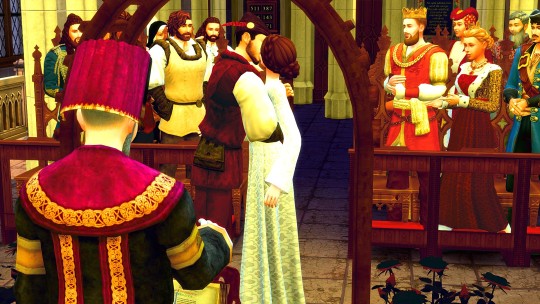



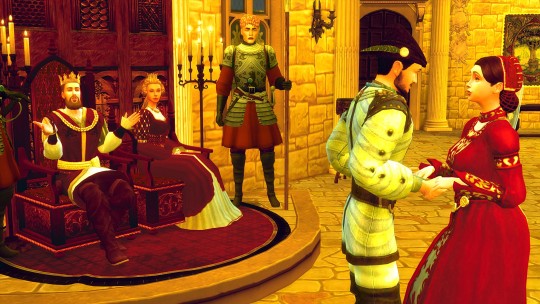






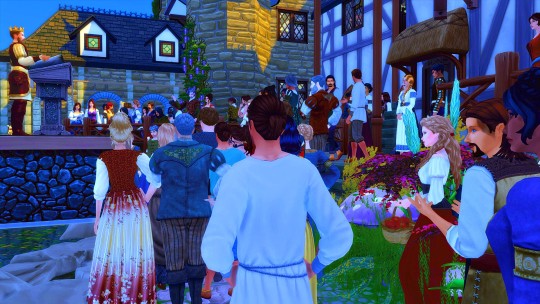

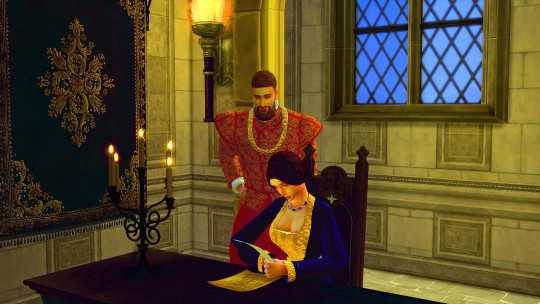
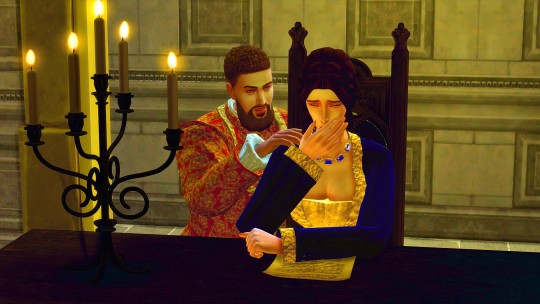











In the summer of 1339, as the rain's gentle touch graced the serene realm of Aarbyville, St. Anthony's Cathedral emerged as a solemn stage for a poignant ceremony. Lady Jane Landgraab, clad in somber mourning attire, her countenance veiled by the shroud of grief, stood beside her 7-year-old son, Lorus. Their hearts weighed heavy, for before them lay the dark stone coffin of Lord Michael Landgraab, who had passed away unexpectedly in his slumber at a mere 40 years of age.
Lady Jane and Lorus, their shared loss etched in their eyes, gazed upon the final resting place of their beloved. Their expressions conveyed profound sorrow, and an aura of disbelief clung to them like a shroud. As the cathedral bells tolled in mournful unison, mother and son leaned upon each other for silent solace, their tears the only words their hearts could speak.
Their shared grief brought them to the tranquil chapel nestled within the cathedral's embrace. Here, silence reigned, providing a sanctuary for their emotions to flow freely. Together, they wept, finding consolation in their shared sorrow, a flicker of light in their darkest hour.
Into this poignant scene stepped Lady Jane's brother, the formidable King Wilhelm of Windenburg. He had come to pay his respects to his brother-in-law and to offer what comfort he could to his grieving sister.
With a heart heavy with sorrow, King Wilhelm approached Lady Jane. His eyes mirrored the shared grief that weighed upon their family. With great tenderness, he expressed his deepest condolences, using words of sympathy and support to alleviate the crushing burden that had fallen upon Lady Jane's shoulders.
Yet Lady Jane's distress ran deeper than mere grief; she was overwhelmed. The responsibilities of her newly acquired title as Lady of Aarbyville had proven to be a burden too great. Lord Michael's sudden and untimely passing had left her in a state of disarray. The prospect of shouldering the governance of the realm, especially with a 7-year-old Lorus in tow, was something she could hardly bear. She felt lost in this unfamiliar role.
Understanding the depths of his sister's despair, King Wilhelm knelt beside young Lorus, his promise to be their unwavering pillar of strength resonating with sincerity. With this pledge of support, Lady Jane glimpsed a glimmer of hope through her tears and embraced her brother in a somber, heartfelt hug.
In the weeks that followed, King Wilhelm became a familiar presence at Castle Landgraab in Aarbyville, the stately home that had graced the Landgraab family since the days of King Otto III of Tredony. Within the confines of her late husband's office, amidst the faint scent of history and the volumes of leather-bound tomes, Lady Jane's inner turmoil became evident. The weight of responsibility bore down upon her, and she struggled to cope with the immense demands of leadership.
Recognizing her predicament, King Wilhelm stood by her side, both as a brother and a ruler. With a heavy heart, he assisted Lady Jane in drafting a decree, one that would relinquish her power and place the realm of Aarbyville under Windenburg's dominion. The decree proposed that Aarbyville would henceforth become a duchy within the expansive realm of Windenburg. It further stipulated that when young Lorus reached the age of 18, he would ascend to the position of Duke, inheriting Castle Landgraab and its responsibilities.
For Lady Jane, this decision was a momentous one. She knew that her signature upon that document would irrevocably alter the course of her life and that of her son. The potential risks and uncertainties weighed heavily on her mind. King Wilhelm, always the supportive brother, placed a reassuring hand upon her shoulder, assuring her that brighter days lay ahead.
King Wilhelm was acutely aware of the strategic importance of this decision. The annexation of Aarbyville was not just about expanding his vast empire; it was also about securing trade routes and a wealth of resources. Aarbyville was strategically located, and seizing power from this region could help King Wilhelm strengthen his political alliances across the globe. This decision had far-reaching implications, and King Wilhelm was resolute in his belief that it was the right path for his kingdom. Aarbyville was once an integral part of the vast Tredonian realm, had remained steadfastly loyal to its Tredonian heritage since the days of King Otto III in the 12th century. When the mighty Tredonian empire fell to Bagley's rule in 1314, Aarbyville chose a different path, emerging as a sovereign state, proudly maintaining its Tredonian roots. Situated along the picturesque coastline, just a few miles from Windenburg's borders, Aarbyville had embraced its unique status. In the wake of the Tredonian empire's decline, this thriving city had evolved into a beacon of commerce and trade, fostering diplomatic relationships with neighboring kingdoms.
In the days that followed, King Wilhelm stood before the people of Aarbyville in the main town square. As he addressed a sea of expectant faces, some filled with trepidation, he outlined the transition into Windenburg's fold. He explained the laws and changes that would come into effect and assured the people that their basic needs, from meat to grain and wine, would be met. With words of hope and prosperity, he promised to rule justly and benevolently.
As the sun dipped below the horizon, King Wilhelm and Queen Cordelia hosted a magnificent banquet at Windenburg Castle. The grand dining room was filled with nobles, royals, and dignitaries from across the realm. The banquet was a celebration of new beginnings, prosperity, and a unified realm.
The tables were laden with a sumptuous feast. A boar's head, fresh-baked bread, a medley of cheeses, an array of succulent meats, and a lavish selection of desserts graced the banquet. It was a celebration that marked not only the integration of Aarbyville but also the dawn of a strengthened realm.
During the banquet, King Wilhelm, ever the astute strategist, observed his favored courtier, Benedict Britechester, gazing intently across the table at Lady Jane. This sight sparked a shrewd idea in the king's mind, one that could benefit not only his kingdom but also Lady Jane's future.
Following the banquet, the celebration continued within the royal court. King Wilhelm and Queen Cordelia presided from their opulent thrones, overseeing the festivities. King Wilhelm then called forth Lord Benedict and Lady Jane to ascend to the dias before the monarchs.
With a voice that resonated throughout the hall, King Wilhelm proposed the betrothal of Benedict and Lady Jane, a union of great honor and strategic importance. It would bind the Britechester bloodline with the royal family of Windenburg for generations to come and Marrying Lady Jane to Lord Benedict would also ensure the Landgraab family's continued loyalty to the crown through her son. This marriage would serve as a binding agreement, solidifying King Wilhelm's control over Aarbyville.
Overwhelmed by this great honor, Benedict took Lady Jane's hands in his. Their eyes locked in a moment of mutual understanding, recognizing that this union was more than politics; it was a connection of two souls.
In the following weeks, as they courted and drew closer, their bond transcended the realms of politics and power. Love blossomed between Lady Jane and Lord Benedict. They found solace and strength in each other, two souls who had weathered the storms of life together.
Lord Benedict not only secured a place in Lady Jane's heart but also embraced a parental role in young Lorus's life. His care and kindness did not go unnoticed by the mourning child. Lorus came to see him not as a stranger but as a guardian and a friend.
By the early fall of 1339, Lady Jane and Lord Benedict were wed at the renowned Westsimster Abbey in a grand and splendid ceremony. It was a union born of politics but solidified by love. As they exchanged their vows, their smiles spoke of the profound connection they had formed.
Following the wedding, King Wilhelm granted the new couple a generous gift. Since his own wedding three years prior, he and Queen Cordelia had worked tirelessly to expand the land that had been gifted to them by King Thomas, Cordelia's father. This area had been transformed into a thriving town with abundant farms and resources. King Wilhelm's gift to the newlyweds was that he had named the realm the duchy of Britechester and appointed Benedict as Duke. The couple came to the throne room at Windenburg Castle, where Wilhelm publicly bestowed upon them the titles of Duke and Duchess of Britechester.
By the spring of 1340, the couple eagerly anticipated the arrival of their first child. It was a testament to the enduring power of love amidst the backdrop of political strategy and destiny. The realm of Windenburg, now further strengthened by the bonds of family and alliance, stood poised for a bright and prosperous future.
#simsmedieval#sims4#windenburg#royalsims#royal#sims#thesimsmedieval#gameofthrones#royalty#simsstory#simmer#historical sims#royalty sims#sim legacy#sims 4#simblr#sims 4 gameplay#sims 4 cc#sims 4 screenshots#my sims#sims 4 edit#14th century#historicalsims#history#historical#historic#world history#legacy challenge#ts4 legacy#sims 4 legacy
52 notes
·
View notes
Text
The first mention of [the St Erasmus chapel at Westminster] comes in a grant issued by Edward IV to the abbey on 13 January 1479 of portions of two manors in Worcestershire [...] The king granted the manors to Elizabeth Woodville on 10 February 1474. Five years later, at the request of the queen, Edward granted the manors to Westminster Abbey in order to fund the chantry she had established there ‘in a chapel of St Erasmus newly built by the queen, annexed to the chapel of St Mary of the monastery, for the good estate of the king and queen and for their souls after death’, and for those of their children. Income from the estates would support two monks to celebrate mass there daily, with the charter setting out the queen’s liturgical instructions.
A previously unnoticed, fragmentary draft of the charter also survives, compiled at some unspecified date before 13 January 1479. It provides a slightly different witness to Elizabeth’s intentions. While the final version specifies placebos and diriges to be sung by the monks on the anniversaries of the eventual deaths of the king and queen around ‘le herse’, the draft more specifically states they are to take place ‘around the tomb of our consort if she is buried there’. This suggests that at this date it might still have been Elizabeth’s intention to be buried at Westminster. This is curious, because Edward himself had made clear as early as 1475 that he wished to be buried at Windsor. He was by then already spending lavishly on its reconstruction to accommodate this. In due course Elizabeth’s body did follow Edward’s to Windsor, but as so often, the final location of a royal burial was a matter of prolonged deliberation (and often contention).
— Matthew Payne & John Goodall, Elizabeth Woodville and the Chapel of St Erasmus at Westminster Abbey
#this is soo interesting#elizabeth woodville#considered being buried on her own in westminster#then years later (after the 1483 crisis) she considered#living there at cheneygates/the abbot's house#what does this mean what does it all meannn#historicwomendaily#edward iv#historian: john goodall#historian: matthew pane
20 notes
·
View notes
Text
Maharani Jind Kaur
Maharani Jind Kaur, also known as Rani Jindan, was a significant figure in Sikh history, serving as the last queen of the Sikh Empire from 1843 to 1846. Born in 1817 in Gujranwala, she became the youngest wife of Maharaja Ranjit Singh, the founder of the Sikh Empire. After Ranjit Singh's death in 1839, Jind Kaur took on the role of regent for her son, Maharaja Duleep Singh.
Jind Kaur's reign as regent was marked by political turmoil and conflict with the British East India Company. In 1845, during the First Anglo-Sikh War, she dispatched the Sikh Army to confront the British, leading to the annexation of the entire Punjab in 1849. After her son's dethronement, she faced imprisonment and exile by the British.
Despite challenges, Jind Kaur escaped captivity in 1849, disguising herself as a slave girl and finding refuge in Nepal. Her efforts to resist British dominance continued through correspondence with rebels in Punjab and Jammu-Kashmir. She later reunited with her son in Calcutta in 1861, influencing him to return to Sikhism.
Jind Kaur's exile took a toll on her health, and she passed away in her sleep on August 1, 1863, in Kensington, England. Denied the opportunity to be cremated in Punjab, her ashes were eventually brought back to India in 1924 and reburied in the Samadhi of Maharaja Ranjit Singh in Lahore.
Despite her challenging life and exile, Maharani Jind Kaur's legacy endures as a symbol of resilience and resistance against colonial rule. In 2009, a memorial plaque was unveiled at the Kensal Green Dissenters Chapel, honouring her contributions to Sikh history.
#sikh empire#jind kaur#mahrani jind kaur#maharaja duleep singh#duleep singh#history#women in history#indian women in history#colonialism#british imperialism#indian royalty
14 notes
·
View notes
Text
The Sun in summer 2022:
The Cambridges' new pad Adelaide Cottage needs no extra taxpayer-funded security or costly refurb.
It's understood the family will have no live-in staff, with any aides commuting to Windsor instead.
And sources say they dream of a "modest" home with a garden so the children can play outside together.
One insider told The Sun: “They were adamant they didn’t want anything too showy or anything that needed renovating or extra security so as not to be a burden on the taxpayer."
The property was modernised back in 2015.
The Daily Mail in June 2022:
Prince William and Kate Middleton will move their family into a four-bedroomed home on the Windsor estate this summer. The Duke and Duchess of Cambridge, are reportedly set to uproot their family from Kensington, west London, to Adelaide Cottage in Berkshire in order to be closer to the Queen.
Re-erected in 1831, the Cambridge’s new Grade II-listed retreat is just a short walk from St George’s Chapel and Windsor Castle, and sits proudly on the 655-acre royal estate in Berkshire.
Victoria Ward for The Telegraph on 14 August 2022:
But in the coming two or three weeks, the Duke and Duchess of Cambridge will do the opposite, swapping their grand Kensington Palace home for a relatively modest four-bedroomed cottage on the Windsor estate, a move that will see them navigate life without a live-in nanny for their first time in their children’s lives.
[...]
Although Ms Borrallo will be kept on full time, she will live elsewhere, as will the handful of other support staff that have long “lived-in” with the family at Kensington Palace, thought to include a housekeeper and a chef.
The Sun on 03 September 2022:
“They had to have moved in this weekend, because the children have to start at their new school next week.
“The renovation is no-frills, by royal standards — and is certainly in stark contrast to the £2.4million work Harry and Meghan had done on Frogmore Cottage. It will have been a builder’s finish.”
Kate and William spent around a year searching for a home in Windsor so the children could go to school together.
They settled on Adelaide Cottage, as first revealed by The Sun, because they believed it needed no major renovations.
They decided to go with existing furniture and fittings but had a fresh coat of paint to make it feel like home for the children.
LESS THAN TWO YEARS LATER...
The Mirror on 15 April 2024:
Prince William and Kate Middleton are reportedly hatching surprise plans to transform a secret home into something of a sanctuary as part of the Princess's recovery process. The Royal couple is said to be contemplating renovations and extensions to a little-known redbrick annexe adjacent to their Adelaide Cottage residence in Windsor. The family, who relocated to the Berkshire estate towards the end of summer 2022, currently divide their time between the four-bedroom cottage and their cherished Anmer Hall retreat on the Sandringham Estate.
While Adelaide Cottage offers an ideal location due to its closeness to Lambrook School where Prince George, Princess Charlotte and Prince Louis attend, insiders suggest the family are considering plans to expand a currently vacant annexe to assist in the princess' recuperation. However, this decision is not without its challenges, as sources indicate that the Prince of Wales is "conscious of public scrutiny" regarding Royal expenditure and is taking a cautious approach to personally funding the costs.
"They [William and Kate] absolutely adore Adelaide Cottage, but it just about fits the entire family, whereas Anmer Hall is much larger with extensive grounds," the source revealed to OK!. "Adelaide Cottage is being used as a term time property while the children are at school nearby and Anmer Hall is for long weekends and holidays."
Insiders have spilled the beans on plans to revamp a run-down redbrick annexe at Adelaide Cottage, aiming to turn it into a perfect retreat for the Wales family and their aides. While the project is on pause as the Princess of Wales focuses on her recovery, the plans are reportedly simmering away in the background, ready to spring into action when the time is ripe.
"Nobody knows that there is quite a spacious red-brick annexe building that's not being used next door to Adelaide Cottage," an insider said. "It's currently inhabitable and needs extensive renovation works if it were to be used. Discussions have been ongoing for a while about using the property as part of the overall cottage grounds, but it's just about finding the right time to kick the project off."
The need for space is more than a luxury; sources say it's vital for Kate's path to wellness, providing her with a serene environment to manage her treatment's demands. Anmer Hall is the top pick at the moment, thanks to its generous size and seclusion. Mindful of past backlash over public funding, the Wales clan is considering footing the bill for the Adelaide Cottage annexe's refurbishments themselves.
"William is very conscious of the public scrutiny over the Royal Family's spending habits, so he is looking at the best way to cover any renovation costs," a source revealed. "It's a project that's very much been put on the back burner for now due to the family's unfortunate position, but it will be looked at again when the time is right."
Adelaide Cottage, tucked away in the Crown Estate's private 655-acre Royal park, was originally constructed in 1831 as a sanctuary for the wife of King William IV, Queen Adelaide. The cottage underwent significant refurbishments in 2015 and boasts some seriously opulent decor. It's said that the master bedroom's ceiling is adorned with gilded dolphins and rope ornamentation, according to various reports.
Well, well, well...
Adelaide Cottage "just about fits the entire family."
"Just about" but not quite, apparently.
Is four bedrooms no longer enough? It was perfectly fine two years ago when they selected it as it "needed no major renovations."
But Kate needs this annex renovation completed for her "path to wellness"? I've never heard of a person undergoing "preventative chemotherapy" needing extensive renovations to their personal real estate to improve their health, particularly when they already have above average living space.
There is a time limit to "preventative chemotherapy." She shouldn't need to be doing "preventative chemotherapy" forever. If she's just doing "preventative chemotherapy," then she should be able to recover within a few weeks after she completes "preventative chemotherapy." (Unless she's really not doing "preventative chemotherapy" to begin with...)
But, hey, if she needs more "space" at home for non-"luxury" reasons, then The Mirror is supporting my previous statement that Kate "is going to be more reclusive for the next year or two."

#fleet street#Matt Wilkinson#Victoria Ward#the telegraph#daily mail#the daily mirror#well well well#Windsor Great Park#real estate#Windsor Castle#Adelaide Cottage#pr games#strategery#kensington palace#palace household#palace staff#kate middleton#Catherine The Princess of Wales#William The Prince of OWN GOALS#William The Terrible#William The Weak#prince william#William The Prince of Wales#Prince & Princess OWN GOALS#Wales fandom ARMAGEDDON#my gif
7 notes
·
View notes
Text
It was thirty years ago today…
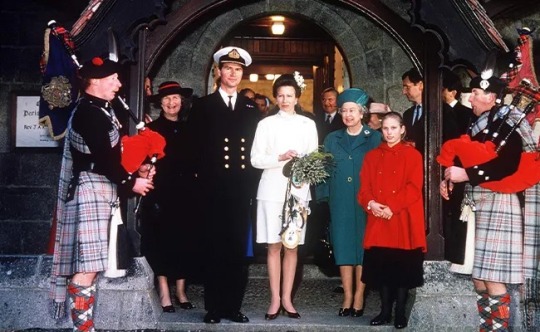
With pipers playing a traditional Scottish air, the wedding party emerges from Crathie Kirk, near Balmoral Castle. From the left: the bridegrooms mother, Mrs Barbara Laurence, Commander Tim Laurence, the Princess Royal, the Queen and the brides daughter, Zara Phillips.
The wedding of The Princess Royal and Commander Tim Laurence
HELLO! Number 233 | Published: December 19th 1992 | Article 1/2
Princess Anne's short and simple wedding ceremony turned into a traditional Highland celebration when she and her husband drove through the gates of Balmoral Castle. Estate workers had prepared an open carriage drawn by fell ponies to take the laughing newlyweds up the hill to their reception in the Queen's Scottish home. It was a romantic ending to an intimate country wedding on Royal Deeside.
Just as the bride had wished, it was a quiet, unpretentious affair with only immediate family plus a few close friends and estate workers present. In stark contrast to the grand state occasion of her first marriage at Westminster Abbey 19 years ago, last week's ceremony was consecrated in a tiny granite kirk on a bleak hill in the remote and beautiful landscape beneath Lochnagar.
Outside Crathie Church, a small crowd had gathered by mid-morning in freezing temperatures, five hours before the bride arrived. The groom, smiling nervously, was the first of the bridal party to arrive with his brother Jonathan and best man Charles Barker-Wyatt. Tim Laurence, 37, wearing the uniform of a Royal Navy commander, looked at the sky and told his friend: "The weather is not too bad."
At 2.50pm the Queen, the Queen Mother and Prince Charles arrived in a Land Rover driven by the Duke of York. He gallantly leaped out to help his 92-year-old grandmother when she said: "I can't get down. Can you help me?" He brought a footstool from the back of the car and placed it by her door so that she could step down without difficulty. Next to arrive was Princess Margaret with Anne's son Peter in another Land Rover driven by Prince Edward.
When the bride finally swept into view down the road from the castle the frozen crowd gave her a warm welcome. As her car, driven by her father, the Duke of Edinburgh, slowly crept past, it was possible to see that Anne, 42, was wearing an ivory woollen suit. Her hair, for the first time in years, flowed down her back beneath a small brown hat decorated with freesias, and she carried a small posy of white Highland heather. In the back seat was her only attendant, her 11-year-old daughter Zara Phillips, in a warm red hooded coat.
The princess removed a brown checked shawl she had worn around her shoulders on the half-mile trip from the castle as the car pulled up outside Crathie Kirk. Then, her happiness clear for all to see, she paused at the church door and checked that Zara was right behind her. When the organ music began she turned to her father, took his arm, grinned and said: "Come on."
The ecumenical Church of Scotland service was conducted by the Minister at Crathie, the Reverend Keith Angus, a member of the Queen's Chapel Royal in Scotland.
The bride did not promise to obey. Instead, according to the ritual of the unrevised Church of Scotland Marriage Service, the couple simply pledged to be "faithful and dutiful" to one another. With Zara Phillips standing beside her mother holding her white heather posy, the Reverend Keith Angus told the couple that "marriage was not to be entered upon lightly or inadvisedly, but thoughtfully."
He reminded them that it was also "ordained for the lifelong companionship, help and comfort, which husband and wife ought to have of each other."
At the end of the solemnisation, the couple knelt together before the lona marble communion table at the front of the wood-panelled church. With the princess kneeling to the left of Commander Laurence, the couple both bowed their heads. The Queen and her family, in their own separate annexe, knelt in pine pews at right angles to the main congregation. Friends and estate workers followed suit as the Reverend Keith Angus recited the "favoured" blessing from the Church of Scotland's Book of Common Order.
At the end of the service, the newly married couple walked into the vestry to sign the register privately. And, just 25 minutes after the bride had walked down the aisle, the wedding was over.
Twilight comes early in the Highlands and dusk was creeping through the valleys as the newlyweds emerged from the kirk to the skirl of bagpipes. Two local pipers played a stirring rendition of the old Gaelic tune Mhairi's Wedding.
Two children who live on the estate then came forward to present the bride with bunches of heather before rejoining a dozen other local youngsters given a prime vantage point by the church door.
The beaming bride then beckoned to her daughter to come forward. “Are we all going to come out?" the Queen asked the Duke of Edinburgh, and when he nodded, the whole family joined Mr and Mrs Timothy Laurence outside.
Meanwhile, Princess Anne turned to her new mother-in-law and showed her the flowers and lucky horseshoes presented by the local children. When another guest asked where they came from, Anne indicated the excited crowd of youngsters on her left and said: "Over there."
As the couple received congratulations, the Queen asked: "Where are we going now?" Princess Anne replied: "We will have to wait to have our photographs taken before we go."
Then the bride stepped back into the blue Land Rover Discovery which had brought her to the church and, with Tim Laurence at the wheel, they drove slowly back down the hill and across the River Dee. Back at the church, the Queen walked over to say hello to the children. "Are you still having your Christmas play next week?" she asked. When informed it was still on, she apologised because she would not be able to attend. "I'm so sorry I will be missing it.
Then the whole family climbed back into their cars and followed the bride and groom on the short drive back to the castle. That is when the estate workers welcomed the newlyweds in true Balmoral style.
It has become a royal custom for the residents on the Queen's Scottish estate to mark special events in the family's lives in this way. When Prince Andrew came home a hero from the Falklands War the estate workers also decorated a cart to carry him from the castle gates. And instead of using ponies the locals pulled the open cart themselves. A similar celebration was arranged when Prince Charles and Princess Diana first visited the castle after their marriage.
On the happy day last week, the bride flung a white woollen shawl around her shoulders to keep out the cold on the slow, but fun-filled journey up the private road leading to the castle portico. Inside, the housekeeper was waiting with a real Highland high tea - including the local black bun, a kind of fruit loaf, that all the royals love so much. An hour after the wedding reception began, it was all over, and the guests began heading back along the Deeside Road to Aberdeen airport.
The princess and her husband drove off to spend their brief three-day honeymoon half a mile away at the grey stone Craigowen Lodge beside the Balmoral golf course. There housekeeper, Hazel Essen, had a warm fire waiting in the drawing room grate to welcome them. Then the newlyweds shut out the world to enjoy being man and wife.
It was not the usual kind of royal wedding. But as the bride once said: "I was never the fairytale princess." For the royal family it was a heart-warming occasion, a happy new beginning at the end of a year during which the Queen and her relatives have been beset by troubles.
It was the first time a divorced member of the Queen's immediate family had remarried. And as the Church of England does not sanction the remarriage of divorces, the princess had decided to hold her wedding north of the border where the Church of Scotland does carry out such ceremonies.
The happy result was a gathering of the blood royal members of the Queen's family in their best-loved rural retreat. It was a show of solidarity by the people who love the bride best - her parents, her three brothers and her grandmother.
Far away from the strife that has surrounded them all year, they could have a happy day privately with the spotlight of the media kept at a distance. And the small crowd who had gathered there to wish them well thoroughly approved of the starkly simple ceremony.
Lena Morrison, a nurse from the nearby village of Cairney, summed up the feelings of many when she said: "Now she is getting her second chance at happiness and we are here to show her and her mother - that we love and support them." The loudest cheers of all came when the Queen passed by.
As her annus horribilis drew to an end everyone seemed to be hoping that the New Year would be filled with many more occasions just as happy as her daughter's second wedding.

The newlyweds with the Princess Royal’s two children Zara and Peter (left). Taking their wedding vows the couple pledged to be “faithful and dutiful”. The bride looked radiant in an ivory fitted outfit with her hair worn loose and carefree.

The official wedding portraits. The bride and groom (left). The immediate families (right), back row, left to right: Commander Timothy Laurence, the Princess Royal and the Duke of Edinburgh. Front row, left to right: Peter Phillips, Mrs Barbara Laurence, Zara Phillips and the Queen.
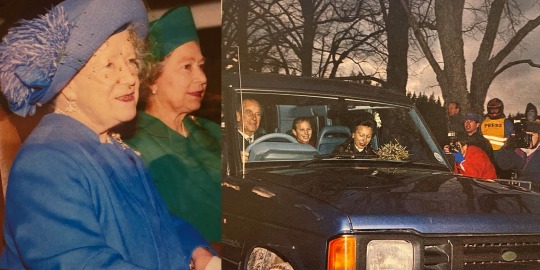
The royal guests arrived in quick succession. Prince Andrew drove the first car with Prince Charles as the front seat passenger, and the Queen and Queen Mother together in the back (left). The bride, with her daughter Zara sitting in the back of the car, was driven to Crathie Kirk by the Duke of Edinburgh (right).

First to arrive was the groom with his best man Charles Barker-Wyatt, a former Navy colleague (left). They waited for a few minutes before going inside the church to wait for the bride who, in keeping with tradition, arrived a few minutes late (right).
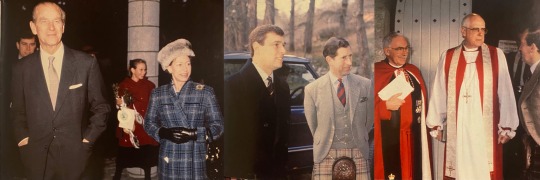
The Duke of Edinburgh and Princess Margaret with Zara in the background holding lucky horseshoes given to her mother (left). Prince Andrew and Prince Charles (centre). Reverend Keith Angus and Right Reverend Michael Mann chat to Brigadier Charles Ritchie (below right).

A joyful bride wearing something old - her ivory woollen suit - and something new - her gold wedding ring, pauses for a brief moment at the door of Crathie Church (left). Looking on, a happy Queen Mother and Zara Phillips with the grooms mother Mrs Barbara Laurence (right).
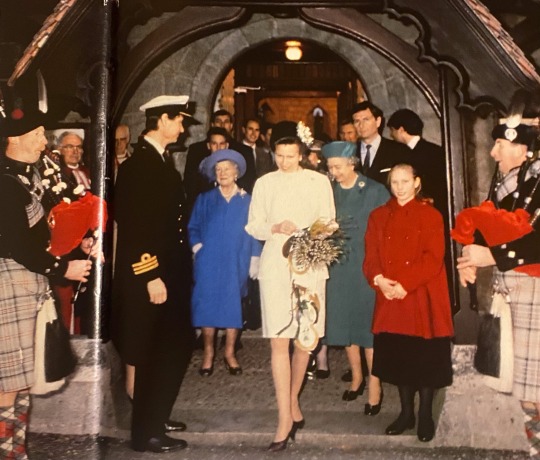
Princess Anne and Commander Tim Laurence step out into their new life together, as delighted family, friends and estate workers crowd around the church door to wish them every happiness for the future. Two local pipers in traditional dress played the Gaelic tune ‘Mhairi’s Wedding’ to greet the newlyweds.

Following the ceremony the Duke of Edinburgh drove the Queen Mother, The Queen and Prince Charles back to Balmoral for the reception (left and centre). Prince Andrew drove Princess Margaret and Prince Edward back from Crathie Church to Balmoral (right). It was cold and dark by the time the royal party arrived at the castle but their spirits were high as they celebrated the Princess Royal’s special day.
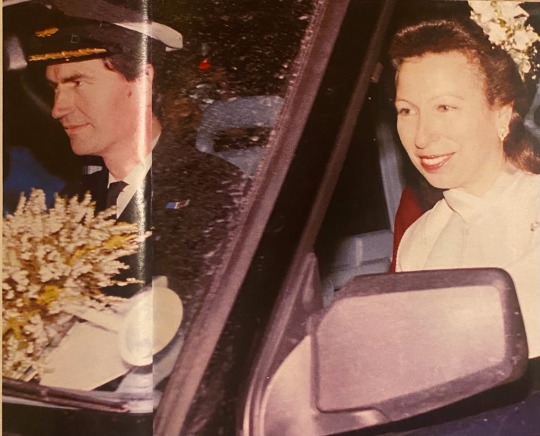
As the newlyweds set off for the reception at Balmoral Castle, the crowds who had gathered outside the church wished them a long, happy and healthy future together. The brides posy of white heather was propped on the dashboard of the couples blue Discovery for the short journey (above).
MAIN PHOTOS: NICHOLAS READ/REX FEATURES
REPORT: JUDY WADE
#wishing them both a wonderful 30th anniversary#and they’re still going strong 30 years later#they deserve all the happiness#get you a man like timothy laurence#always there to support his wife#they are so in love and always have been#cutest couple in the brf#hello magazine#crathie kirk#balmoral castle#1992#princess anne#princess royal#tim laurence#timothy laurence
97 notes
·
View notes
Text
Star Trek Wars and Responsible Allegory
The ending for Strange New Worlds season premiere has me setting yellow alert. Mild spoilers follow.
I trust the writers and showrunners of Strange New Worlds.
I trust them to maintain a fundamentally optimistic worldview while not shying away from the impact of what the characters are experiencing. M’Benga and Chapel illustrated that beautifully.
Strange New Worlds is an easier watch than Picard, and that is to be expected. As I’ve passionately argued, Picard is a show about damaged people bereft of resources and facing hard moral dilemmas. Star Trek the Next Generation and Strange New Worlds are about the elite, handpicked for their gifts, provided every advantage, and with the best ship in the fleet insulating from the consequences of poorly calculated risks.
Neither is a better concept! Although even with an open heart, Picard is not an easy show to watch. I love Strange New Worlds for its ability to go down smoothly without feeling stupid. I’m unbelievably burnt out on hopeless suffering and bleak universes that defy attempts to improve them.
Which is why the implications of a Gorn war story alarm me so much.
My ethics call me to be pro-Ukraine but anti war propaganda.
Do you follow that nuance?
I’ll unpack it.
If the Ukraine War is something the Strange New Worlds production feels it needs to acknowledge in some fashion and allegorize, then using the take on the Gorn we’ve seen to date speaks to the soul scorching atrocities of the Russian invasion force, but little else about this conflict.
The likely Gorn motive of expansion for expansion’s sake is not an inaccurate parallel to Russia but it is superficial. It's comfort food for those of us rooting for the speedy removal of Russia’s occupation and horrified by the carnage wrought, but frankly Star Trek doesn’t need to be that ham fisted. It has a history of treating war as more than a spectator sport and seeking a deeper, richer understanding of the origins of conflict.
The Gorn, thus far, are entirely lacking in the sort of dimensionality and nuance that would make them compelling villains or hold a mirror up to our world to seek more profound truths. They’re the sort of villains to consume war as content, not understand war.
For all the slings and arrows directed at Discovery, something it did right with its Klingon War arc is show how actually it's not entirely about cynical, material motives like those of us who see the machinations of greedy oligarchs behind society’s ills would prefer to think is generally the rule.
T’Kuvma’s supremacist ideology, contempt for other cultures, and “fear” of assimilation and loss of identity is familiar to students of the intellectual rationalizations of Russia’s invasion. That’s not coincidental. T’Kuvma was rather clearly meant to stand in for various strains of ultranationalism and ethnonationalism circulating at the time.
T’Kuvma is reminiscent of Orban, Trump, Johnson etc. because the advisers whispering in their ears were themselves inspired by if not directly, then by very few degrees of remove, by Alexander Dugin and other architects of the Dark Enlightenment values that gave Putin the labels and rationales to crush both political threats to his regime and people he found aesthetically repugnant. These same Dark Enlightenment values create the permission structure for invasions, annexations, and the systematic murder of Ukrainian public intellectuals, civil leaders, and other cultural figures.
Now of course other Klingon House Leaders, oligarchs if you will, flock to T’Kuvma’s banner for their own cynical reasons, but much of our current reality is difficult to explain using an entirely cynical, materialist framework. If only because it's hard to imagine how the most outrageously successful (for Russia) invasion would have been a profitable enterprise without a myopic degree of cultural supremacism and complete disregard for the idea that this invasion might fail utterly to achieve any goal that would shore up and enrich the Russian economy, demography, or even just enrich the already extravagantly wealthy.
In the Dominion War, we find the Founders, themselves consumed by a supremacist and xenophobic worldview, using Jem’Hadar and Cardassians alike as phaser fodder with the casual attitude of Skynet deploying a wave of Terminators.
At one point DS9 even manages to humanize the Jem’Hadar. Outmatched and Ketracel White starved survivors recognizing the futility of their assault on a prepared Starfleet position, but unwilling or unable to shake off their conditioning to choose surrender. Even the betrayal of this band’s Vorta is reminiscent of accusations that Wagner was leaking intelligence on the Russian army in exchange for lighter treatment from Ukrainian forces.
Meanwhile, Damar portrays the horror of recognizing an ally is intentionally wasting the lives of your people for a cause that seemed worthy in the beginning, but has been exposed as inevitably bringing greater ruin not glory. Damar drowns his grief in kanar because he can’t see a way out. His own cultural heritage has left him without much of a tangible idea of a different society to hope for and fight for. Eventually though, he realizes if he doesn’t do something the humiliation of losing a war will be just the beginning of the horrors visited upon the Cardassian people.
Damar is many characters. He’s the separatist who realized his “liberator” cares nothing for him except as a prop to rationalize the war and will sell his life cheaply once his part in the narrative is no longer interesting. Damar is the homegrown resistance to the war in Russia we scan the news desperately searching for.
The Gorn of Strange New Worlds can allegorize the depravity of the Russian invasion, but it would be a caricature in every other respect. Good allegory shouldn’t simply inspire us, it should inspire dissent and righteous rebellion were it to leak across digital iron curtains. If Star Trek is to dabble in propaganda, then it should not just be about great victories on the battlefield, it should describe a better future.
Sorry George, there are not heroes on both sides, but there are victims. Yet the Gorn really don’t seem like they can be victims unless Strange New Worlds is preparing to show us a different side of them. Maybe we’ll see some Gorn convicts used as phaser fodder or sympathizers who thought they were purchasing freedom with their loyalty but have found themselves instead press ganged with bottom of the barrel equipment in hand.
#star trek#star trek ethics#propaganda#allegory#war stories#Strange New Worlds#Strange New Worlds spoilers#spoilers#first reactions#Gorn#Dominion War#Klingon War
23 notes
·
View notes
Text

New York Times bestselling and Bram Stoker Award-winning author Christopher Golden (Ararat, All Hallows) will publish The House of Last Resort on January 30.
The 304-page horror novel will be available in hardcover and e-book via St. Martin's Press. Read the synopsis below.
Across Italy there are many half-empty towns, nearly abandoned by those who migrate to the coast or to cities. The beautiful, crumbling hilltop town of Becchina is among them, but its mayor has taken drastic measures to rebuild―selling abandoned homes to anyone in the world for a single Euro, as long as the buyer promises to live there for at least five years.
It’s a no-brainer for American couple Tommy and Kate Puglisi. Both work remotely, and Becchina is the home of Tommy’s grandparents, his closest living relatives. It feels like a romantic adventure, an opportunity the young couple would be crazy not to seize. But from the moment they move in, they both feel a shadow has fallen on them. Tommy’s grandmother is furious, even a little frightened, when she realizes which house they’ve bought.
There are rooms in an annex at the back of the house that they didn’t know were there. The place makes strange noises at night, locked doors are suddenly open, and when they go to a family gathering, they’re certain people are whispering about them, and about their house, which one neighbor refers to as The House of Last Resort. Soon, they learn that the home was owned for generations by the Church, but the real secret, and the true dread, is unlocked when they finally learn what the priests were doing in this house for all those long years…and how many people died in the strange chapel inside. While down in the catacombs beneath Becchina…something stirs.
Pre-order Christopher Golden's The House of Last Resort.
#christopher golden#the house of last resort#horror#horror books#horror novel#st. martin's press#bram stoker#bram stoker award#new york times best sellers#book#gift#ararat#all hallows
17 notes
·
View notes
Text
State march masterpost (updated as information comes in!)
All times are local time unless otherwise specified. Reblogs are off because this is a living, regularly updated post; please see our website or send an ask for more information!
Post you can reblog is here.
Alabama:
Florence—114 W Mobile St -> 200 S Court St, 3/31, 3:30pm (link)
Montgomery—Alabama State House, 3/31, 1pm (link)
Alaska:
Anchorage—Dimond Center -> Costco Wholesale, 3/31, 12pm
Arizona:
Prescott—Prescott Courthouse, 3/31, 2pm
Sierra Vista—Fry and Coronado -> City Hall, 3/31, 3pm (link)
Tuscon—Tuscon City Hall, 3/31, 4pm (link)
Arkansas:
Eureka Springs—Basin Spring Park, 3/31, 6pm (link)
Little Rock—Lucie’s Place, 3/31, 6pm
Marion—Brunetti Park -> Marion City Hall, 3/31, 5pm
California:
Castro Valley—Castro Valley High School (non-students please join in once the protest has left school grounds) -> Corner of Redwood Rd and Castro Valley Blvd, 3/30, 3:35pm (link)
Fresno—N Blackstone Ave & E Nees Ave, 3/31, 4pm (link)
Hollywood—Corner of Sunset & Vine, 3/30, 4:15pm
Merced—3055 Loughborough Dr -> Laura's Fountain -Applegate Park 1045 W 25th St, 3/31, 4:30pm (link)
Pomona—Pomona Pride Center 836 S -> City Hall, 3/31, 4pm (link)
Riverside—Back To The Grind Coffee Shop –> Riverside City Hall, 3/31, 4pm (link)
Sacramento—Capitol Complex, 3/31, 12pm (link)
San Diego—Balboa Park at the Bea Evenson Foundation -> El Prado, 3/31, 5pm
San Francisco—Corner of Turk & Taylor -> City Hall, 3/25, 11am (link) | Patricia's Green -> City Hall, 3/31, 2:15pm (link)
San Jose—San Jose City Hall, 3/31, 5:30pm (link)
Santa Ana—Brad Brafford LGBT Center on 4th, 3/31, 6pm (link)
Colorado:
Denver—Civic Center Park, 3/17, 8:30pm | West Steps of the Capitol, 3/24, 11am (link)
Connecticut:
Bristol—131 N Main Street, 3/31, 1pm
Fairfield—Upper Quad of Sacred Heart University, 3/31, 4pm
New Haven—corner of Chaple and Church St, 3/31, 4pm
Delaware:
Wilmington—Delaware Historical Society –> Rodney Square, 3/31, 6pm (link)
District of Colombia:
Union Station -> US Capitol, 3/31, 3pm (link)
Florida:
Altamonte Springs—3/31, 9am (link)
Naples—Cambier Park, 3/31, 6pm (link)
Ocala—Pine Plaza -> City Hall, 3/31, 3:30pm
Orlando—Dr Philips Performing Arts Center, 3/31, 11am
Port Orange—Corner of Yorktowne Blvd. and Dunlawton Ave -> Port Orange Regional Library, 3/31, 4:30pm
Tallahassee—state Capitol building, 3/31, 2pm (link)
Venice—Town Center -> Venice Beach, 3/31, 10:30am
Georgia:
Atlanta—state Capitol building, 3/31, 12pm (link)
Dalton—3/31, 11am (link)
Gainesville—Gainesville Square –> Jesse Jewell Parkway (in front of CVS), 3/31, 5pm
Savannah—Forsyth Park -> City Hall & back, 3/31, 6pm
Hawaii:
Honolulu—state Capitol building, 3/31, 3:30pm
Idaho:
Boise—TBD
Shelley—Shelley City Park, 3/31, 2pm
Illinois:
Champaign—McKinley Foundation Church Chapel, University of Illinois, 3/31, 5:30pm
Chicago—Grant Park, 3/31, 5pm
Rockford—1005 5th Ave, 3/31, 5pm (link)
Streamwood—7 Augusta Dr –> 7 S Sutton Rd, 3/31, 8am (link)
Indiana:
Fort Wayne—Boone Street Playlot -> Allen County Courthouse, 3/23, 3pm (link) | Allen County Courthouse, 3/31, 5pm (link)
Hanover—Hanover College Quad, 3/31, 1pm
Indianapolis—433 N Capital Ave -> 1 Monument Circle, 3/31, 3pm
Terre Haute—Terre Haute Courthouse, 3/31, 5pm
Iowa:
Des Moines—state Capitol building (West Capitol Terrace Stage), 3/31, 6pm (link)
Dubuque—Dubuque Courthouse -> Washington Park, 3/31, 4pm (link)
Iowa City—Pentacrest -> Wesley Center, 3/31, 6pm (link)
Kansas:
Lenexa—Lenexa Rec Center -> City Hall, 3/31, 5pm
Topeka—state Capitol building entrance, 3/31, 5pm (link)
Wichita—121 E Douglas Ave, 3/31, 4pm (link)
Kentucky:
Frankfort—front of Annex Building, 3/29, 9:30am (link) | Kentucky State Capitol, 4/8, 1pm (link)
Lawrenceburg—Anderson County Courthouse -> 44 Anna Mac Clarke Ave, 4/3, 3pm (link)
Lexington—Robert F. Stephens Courthouse Plaza, 3/31, 4:30pm | Outside of the Old Fayette County Courthouse, 3/31, 6pm
Louisiana:
Lake Charles—Prein Lake Park, 3/31, 12pm
New Orleans—Washington Square Park 700 Elysian Fields Ave, 3/31, 5pm (link)
Maine:
Bangor—West Market Square, 3/31, 6pm
Portland—456 Congress St, 3/31, 6pm (link)
Rockland—Intersection of Main Street and Park Street (near Walgreens and Maine Sport) –> Chapman Park, 3/31, 5:30pm
Maryland:
Baltimore—400 E Biddle St, 3/31, 5pm
Oakland—32 Oak St –> 305 E Oak St, 3/31, 3pm (link)
Massachusetts:
Boston—state house, 3/18, 11am (link) | state house, 3/28, 10am (link)
Sunderland—North Star, 45 Amherst Road, 3/31, 12pm
Michigan:
Detroit—Woodward-Warren Park, 3/31, 5pm (link)
Fenton—Rackham Park, 3/31, 6pm (link)
Grand Rapids—Downtown, 3/31, 5pm
Lansing—state Capitol building, 3/31, 11am
Minnesota:
Saint Paul—state Capitol building, 3/31, 9am (link)
Mississippi:
Missouri:
Columbia—701 East Broadway Blvd, 3/31, 5:30pm (link) | Uptown Columbia –> Downtown Columbia, 4/15, 9am
Jefferson City—Missouri State Capitol, 3/29, 2pm (link)
St Louis—11911 Dorsett Rd –> 715 NW Plz Dr, 4/27, 1pm
Montana:
Missoula—Missoula Courthouse, 3/31, 5pm (link)
Nebraska:
Lincoln—state Capitol building, 3/31, 5:30pm
Nevada:
Las Vegas—Las Vegas TransPride Center -> The LGBTQ Center of Southern Nevada, 3/31, 11am (link)
New Hampshire:
Keene—Keene State College Campus Main Entrance -> Center Square, 3/31, 5pm (link)
New Jersey:
Flemington—Flemington Historic Courthouse -> Flemington DIY, 3/31, 3:45pm (link)
Trenton—State House, 3/31, 3pm (link)
New Mexico:
Albuquerque—Civic Plaza, 3/31, 5pm
Santa Fe—State Capitol -> the Attorney General's office, 3/31, 11am
New York:
Albany—Washington Square Park -> Capitol Park, 3/31, 1pm
Canandaigua—7 Mill St, 3/31, 3pm
Forest Hills—Forest Hills Station, 3/31, 2:30pm
New Paltz—SUNY New Paltz Campus, 3/31, 3:30pm
New York City—Union Square -> Washington Square Park, 3/31, 5pm (link) | Times Square, 3/31, 5pm
Penn Yan—Yates County Courthouse, 3/31, 3pm (link)
Plattsburgh—Hawkins Pond -> Samuel Champlain Monument Park, 3/23, 3pm
Utica—Genesee-Parkway Intersection, 3/31, 5pm
Westchester—SUNY Purchase College, 3/31, 5pm
North Carolina:
Asheville—TBD
Mooresville—Freedom Park -> Town Hall, 3/31, 2:30pm (link)
Raleigh—John Chavis Memorial Park, 3/31, 1pm
Wilmington—Historic Thalian Hall Steps, 3/31, 5pm (link)
North Dakota:
Ohio:
Cleveland—Free Stamp @ Willard Park -> City Hall, 3/31, 4pm
Cleveland Heights—City Hall, 3/31, 11am (link)
Columbus—Goodale Park, 3/31, 5pm
Dayton—Lily’s Dayton (329 E 5th St) –> Courthouse Square (23 N Main St), 3/31, 4pm
Lakewood Park—Lakewood Park, 3/31, 4pm (link)
Madison—Madison Village Square Park, 3/31, 4pm (link)
Oklahoma:
Oklahoma City—Supreme Court of Oklahoma -> state Capitol building, 3/31, 5pm
Tulsa—Central Library, 3/31, 4pm (link)
Oregon:
Bend—Drake Park, 3/31, 5pm
Hillsboro—Civic Center -> 145 NE 2nd Ave, 3/31, 5pm
Medford—Vogel Plaza 200 E. Main Street, 3/31, 4pm
Portland—Tom McCall Waterfront Park -> Pioneer Courthouse, 3/31, 2pm
Pennsylvania:
Harrisburg—state Capitol building, 3/31, 1pm (link)
Oil City—Oil City -> Franklin, 3/31, 8am
Philadelphia—Temple University Bell Tower, 3/29, 1pm (link) | City Hall, 3/31, 6pm (link)
Pittsburgh—City County Building, 3/31, 5pm (link)
Rhode Island:
Providence—the Wheeler School -> state Capitol building, 3/31, 11:30am
South Carolina:
Columbia—State House Grounds, 3/31, 2pm
Greenville—300 S Main St, 3/31, 3pm (link)
South Dakota:
Brookings—City Council Building, 3/31, 5pm (link)
Rapid City—Main Street Square, 3/31, 5pm
Tennessee:
Knoxville—Downtown Hilton, 3/31, 10:30am (link) | Gay Street & Market Square (where the water fountain markers are), 3/31, 2pm
Memphis—Civic Center Plaza, 3/16, 4pm
Texas:
Amarillo—Amarillo Chamber of Commerce -> Potter County Courthouse, 3/31, 5pm
Austin—state Capitol building, 3/20, 9am (link)
Dallas—Main St Garden Park 1902 Main St, 3/18, 12pm (link) | Pacific Plaza, 3/31, 3pm
Houston—Discovery Green Park -> City Hall, 3/31, 11:30am
Killeen—101 N College St -> 1114 N Fort Hood St, 3/31, 5:30pm
Lubbock—Mahon Library parking lot -> county Courthouse, 3/31, 5pm
San Antonio—San Antonio Courthouse, 3/31, 6:30pm (link)
Utah:
Salt Lake City—state Capitol building, 3/31, 5pm (link)
Vermont:
Montpelier—Montpelier State House, 3/31, 12pm (link)
Virginia:
Richmond—Open High School -> state Capitol building, 3/31, 3pm
Washington:
La Center—by the bridge into town, 3/31, 5pm
Olympia—Heritage Park -> state Capitol building, 3/31, 3:30pm
Seattle—SeaTac Airport Station, 3/31, 1pm | Volunteer Park -> Seattle Courthouse, 3/31, 4pm (link)
Spokane—Cracker Building, 3/18, 12pm (link)
Walla Walla—Pioneer Park -> Land Title Plaza, 3/31, 3:45pm (link)
Wenatchee—Memorial Park, 3/31, 4pm
West Virginia:
Charleston—3/31, 4:30pm
Wisconsin:
Appleton—Houdini Plaza, 3/31, 10am (link)
Janesville—Corner of East Court Street/Jackman Street -> Corner of West Court Street/South Locust Street, 3/31, 2pm
Kenosha—Civic Center Park, 3/31, 12pm
Madison—Library Mall, 3/18, 2:30pm (link) | 534 State St –> Wisconsin State Capitol, 3/31, 12pm
Milwaukee—TBD
Wyoming:
CANADA: Toronto, Ontario
3/17, 3pm, US Consulate (link)
#queer youth assemble#march for queer and trans youth autonomy#queer youth#queer pride#queer#trans healthcare#trans rights#trans#trans day of visibility#transgender#activists#activism#youth rights#protest
26 notes
·
View notes
Text

The first of two sections of The Bridge connecting the main house, via the Potting Room, to the conservatory/greenhouse/natatorium. A second bridge, opposite, would connect to the Chapel Annex.
29 notes
·
View notes
Text
Kings of Mallorca out of the islands
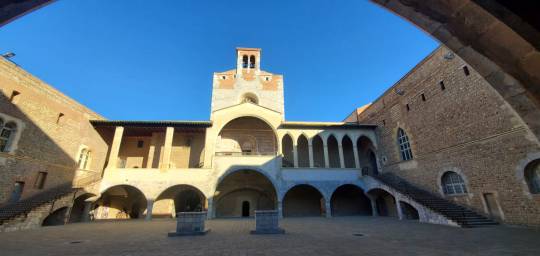
The Palace of the Kings of Mallorca was built by King Jaume II in Perpinyà in 1276, when he assumed the crown of the new kingdom established ten years earlier by Jaume I the Conqueror.
It was the main centre of power for the territories that the new kingdom brought together: the Balearic Islands, the counties of Roussillon and Cerdanya, the lordship of Montpellier, inherited by Jaume I from his mother, Maria, and other fiefs north of the Pyrenees.
Gardens and several chapels were built in the palace, which is protected by powerful walls and a moat. These were consecrated when the complex was completed around 1309, even while King Jaume II of Mallorca, who suffered the temporary loss of his island territories to his uncle, Alfonso III of Aragon, during his reign.
When the islands were recovered around 1291, following the death of the Aragonese king and an arbitration decision by the papacy, James II continued to build the kingdom both in Mallorca and in Roussillon. He was able to enjoy the completed fortress for only two years, as he died in 1311 and was succeeded by his son Sanç.
Sanç I of Mallorca, who became king when his older brother renounced the crown to become a Franciscan friar, continued his father's work and began to build a naval power based on the insularity of most of his kingdom. He clashed with the institutions of the capital of Mallorca.
He died childless in 1324, and was succeeded by his nephew as Jaume III, who immediately assumed vassalage to his relative, King Pere IV of Aragon, whom he supported in the conquest of Sardinia and in the war with the Republic of Genoa.
The Crown of Aragon wanted to annex the kingdom again. Pere IV seized the islands in 1343 and the trans-Pyrenean counties in 1344. Jaume ceded the rest of the baronies to the King of France in exchange for support to recover his kingdom.
The Mallorcan royal dream ended at the Battle of Llucmajor in 1349, certified by the death of Jaume III in the same year. His son claimed the crown of the short-lived kingdom under the name of Jaume IV, but was unsuccessful and his territories were reincorporated into the Crown of Aragon.
After this, the palace of the kings of Mallorca in Perpinyà lost its importance and was only a royal residence when the Catalan-Aragonese monarchs visited their territories in what is now Northern Catalonia.
The wars between the Aragonese and French crowns throughout the 15th century meant that the palace-fortress centralised the defence of the territory. Between 1538 and 1587, Kings Carlos I and Felipe II of Spain enlarged the enclosure with brick walls.
The Treaty of the Pyrenees (1659), by which Spain ceded the former Catalan counties of Rosselló, Cerdanya, Vallespir and Conflent to France, ushered in the French occupation. During the occupation, the military engineer Sébastien Le Prestre, first Lord and then Marquis of Vauban, reinforced the defensive system of what is still today a partially military enclosure.
4 notes
·
View notes
Note
what are the official residences of the various warwick families, and can you give us some history/fun facts about each residence?
Anon this is a lovely question, anon, and it's one that's actually encouraged me to begin making a map of my country and where each royal residence is listed.
In Sunderland, a royal residence is a castle, palace, or house in which a member of the royal family lives. Some are considered Crown properties (AKA taxpayer's money fund them), while others are privately owned. Some are only occupied on seasonal or irregular occasions, while others are full-time residences. Below is a quick list of some of these residences:
CHESTER PALACE - Chester Palace is located in Warwick, Sunderland's largest city. It is the main residence of The King and serves as the royal family's administrative headquarters. The offices of the King's surviving sons are located there as well. Despite not being located in Woodbine, the nation's capital city, most state functions are held at Chester Palace, which is more accessible and modern than the older Woodbine Castle. It was refurbished extensively during the 19th Century to accommodate all manners of people, including palace staff, politicians, ambassadors, and tourists. It is often the focal point of the city during times of celebration and morning alike.
COLLINGWOOD CASTLE - Collingwood is a large estate house located four hours north of Warwick. It became the summertime residence of the royal family when it was purchased in 1872 and is private property. Since then the Collingwood Estate has grown, covering tens of thousands of acres, and is home to a wide variety of unique wildlife and landscapes. While secluded from the public, the estate is a working one, and members of the royal family are free to hunt and fish. Collingwood is also home to extensive farmland.
ELLESMERE PALACE - By the mid-19th century, Sunderland had completed much of its expansion westward, and annexed a territory that became known as New Westminister, covering most of Sunderland's northwest coast. Ellesmere Palace is the official residence of the monarch when he is in western Sunderland and is used for local state functions and events. Traditionally, the monarch will spend a few weeks out of the year at Ellesmere, where they would carry out official engagements and events. Due to its proximity to the Scarborough campus of the Royal Military College, members of the royal family have also lived at Ellesmere Palace while engaging in military training and serving domestically.
ROSEDALE HOUSE - Rosedale House and Estate is located in Sunderland's midwest. It is a relatively new royal residence, and is relativly small when compared to other royal residences. It was the country retreat of Queen Anne throughout the 1930s, who tended to the gardens and decorated the house to her tastes. Following the death of her eldest son, Prince George in 1942, Anne isolated herself from the rest of the family at the estate. Following Queen Anne's death, the property has sat largely abandoned until the mid 2020s, when Anne's great-grandson Prince Phillip leased the property from the Crown.
ST MARY'S PALACE - St Mary's is a red-brick palace and the smaller of the two royal palaces in Warwick. It is home to the offices of less senior members of the royal family, and is the headqauters of the King's Royal Court. It is also known as the Curator's Palace due to its numerous artisitc collections and galleries. St Mary's is often the venue for high-profile charity and soceity events. St Mary's Royal Chapel is still used for fuctions of the royal family and the ocassional royal wedding.
WARWICK HOUSE - Warwick House is a country house and, despite the name, is located in Woodbine, just ten minutes outside of the downtown core. Warwick House is famously where the royal family spends Christmastime each year, and the King himself spends roughly two months on the property between November and January. Much like Collingwood, Warwick House is an extensive estate with a dedicated hunting culture. The propery is praticularily beloved by members of the royal family and is regarded as a family retreat. Throughout its history, several members of the family have been born and died on the grounds.
WOODBINE CASTLE - Woodbine Castle is the oldest and largest royal residence. Woodbine is a summit castle, that was built in the Gothic Revival style in order to resemble the European strongholds of antiquity. In a way, it's like the ancestorial seat of the royal family and its proximity to the federal government allowed it to be a venue for many state events. However, in the 19th and 20th centuries, the old Woodbine Castle grew neglected by members of the family. Recent Warwick kings preferred the more modern Chester Palace as their main residence. However, once Louis V took the throne in 1970, he began to make changes and minor renovations to the colossal lake-side castle. Now, he favours it as his weekend residence and country retreat. Several members of the royal family live on the grounds of Woodbine Castle, in smaller properties once dedicated to staff.
8 notes
·
View notes
Photo



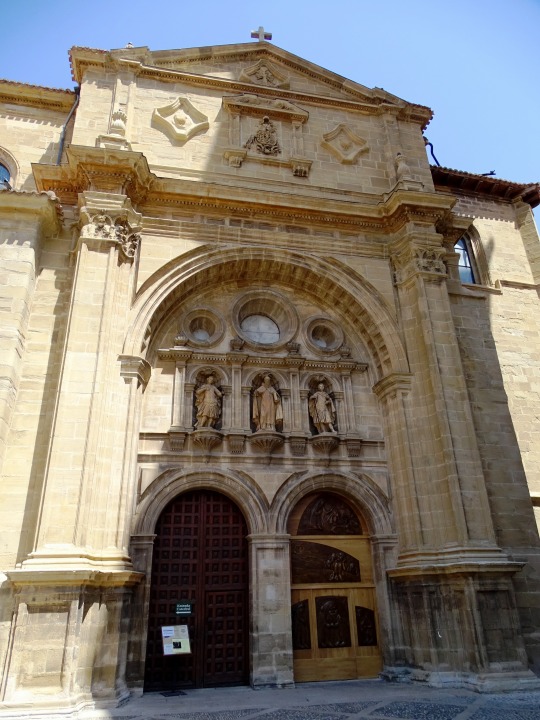


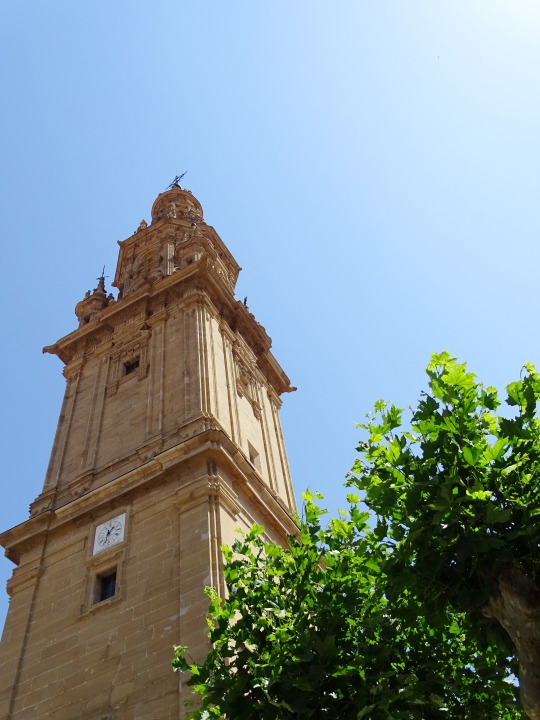



Cathedral of Santo Domingo de la Calzada, Spain (No. 2)
The building has a Latin cross plan divided into three large naves that have attached chapels. After a transept, which is marked in plan and elevation, they give in a main chapel that has, as is proper in the temples of pilgrimage, an ambulatory or ambulatory surrounded, at the same time, by different radial chapels and the outstanding central apdiole. The cloister opens to the northern side, where it is annexed to the rest of the temple.
Portada Sur
The south façade or Santo Domingo, with a large semicircular arch, which protects niches with statues of the patrons of the diocese, Santo Domingo, San Celedonio and San Emeterio) and circular oculi, was built between 1761 and 1765.
Bell Tower
The cathedral had, throughout its history, three towers. The primitive Romanesque was destroyed in a fire in 1450. The second, Gothic, had to be dismantled when threatening ruin. The third, Baroque, is the one that currently exists.
It is one of the few examples in Spain, of exempt tower (tower separated from the main body of the cathedral), is the work of the architect Martín de Beratúa under the patronage of Bishop Andrés Porras y Temas in 1762. It is of baroque style with a bell tower of the architecturally called Riojan style and, with its 70 meters high and a base of 9 meters, it is the tallest tower in La Rioja.
The legends of the place tell that the reason for the separation of the tower from the body of the cathedral is due to the fact that sandy soils were found that prevented firm foundations. In the end there was an excellent location, the current one, in which to ensure the foundations were added horns of deer and cows of the place
Source: Wikipedia
#Plaza de Santo#Portada sur#bell tower#Romanesque#Gothic#Baroque#Martín de Beratúa#Riojan style#Cathedral of Santo Domingo de la Calzada#Santo Domingo de la Calzada Cathedral#Santo Domingo de la Calzada#Spain#Camino de Santiago#Way of St James#Garçion#pilgrimage church#España#La Rioja#exterior#detail#travel#vacation#summer 2021#old town#pedestrian zone#tourist attraction#landmark#tree#architecture#cityscape
5 notes
·
View notes
